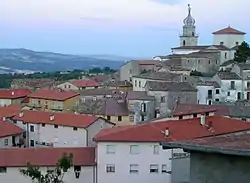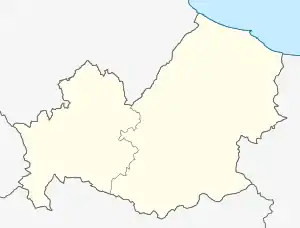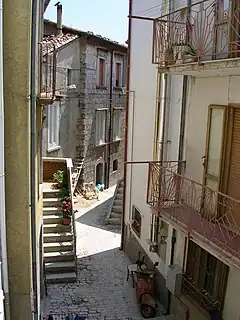Sepino
Sepino is a comune (municipality) in the Province of Campobasso in the Italian region Molise, located about 20 kilometres (12 mi) south of Campobasso. It is a member of the I Borghi più belli d'Italia ("The most beautiful villages of Italy") association.[4]
Sepino | |
|---|---|
| Comune di Sepino | |
 | |
 Coat of arms | |
Location of Sepino | |
 Sepino Location of Sepino in Italy  Sepino Sepino (Molise) | |
| Coordinates: 41°24′N 14°37′E | |
| Country | Italy |
| Region | Molise |
| Province | Campobasso (CB) |
| Government | |
| • Mayor | Paolo Pasquale D'Anello |
| Area | |
| • Total | 61.37 km2 (23.70 sq mi) |
| Elevation | 698 m (2,290 ft) |
| Population | |
| • Total | 1,915 |
| • Density | 31/km2 (81/sq mi) |
| Demonym | Sepinesi |
| Time zone | UTC+1 (CET) |
| • Summer (DST) | UTC+2 (CEST) |
| Postal code | 86017 |
| Dialing code | 0874 |
| Website | Official website |

The archaeological site of Saepinum is located nearby. Sepino borders the following municipalities: Cercemaggiore, Cercepiccola, Guardiaregia, Morcone, Pietraroja, San Giuliano del Sannio, Sassinoro.
In the early 7th century AD, what are today the communes of Sepino, Isernia and Bojano were the places where Grimoald I of Benevento settled a group of Bulgars, seeking refuge from the Avars; the Bulgars were for many generations a distinctive part of the population, until finally assimilated in their Italian environment (see Bulgarians in Italy, Old Great Bulgaria#Bulgars in Southern Italy).
Beginning in the late 19th century, many residents of Sepino have immigrated to other countries. The earliest waves migrated to the United States (particularly Hartford) and Argentina, and after World War II many moved to Canada, Australia, Brazil, Uruguay, Venezuela, and other European countries besides Italy, namely Belgium and West Germany. [5]
References
- "Superficie di Comuni Province e Regioni italiane al 9 ottobre 2011". Italian National Institute of Statistics. Retrieved 16 March 2019.
- All demographics and other statistics: Italian statistical institute Istat.
- "Popolazione Residente al 1° Gennaio 2018". Italian National Institute of Statistics. Retrieved 16 March 2019.
- "Molise" (in Italian). Retrieved 1 August 2023.
- "Il Giornale di Santa Cristina". Il Giornale di Santa Cristina (Multiple). 1895–2019.